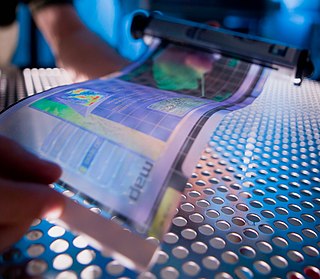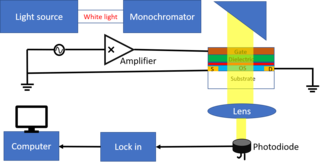Related Research Articles

Organic electronics is a field of materials science concerning the design, synthesis, characterization, and application of organic molecules or polymers that show desirable electronic properties such as conductivity. Unlike conventional inorganic conductors and semiconductors, organic electronic materials are constructed from organic (carbon-based) molecules or polymers using synthetic strategies developed in the context of organic chemistry and polymer chemistry.
Molecular electronics is the study and application of molecular building blocks for the fabrication of electronic components. It is an interdisciplinary area that spans physics, chemistry, and materials science. The unifying feature is use of molecular building blocks to fabricate electronic components. Due to the prospect of size reduction in electronics offered by molecular-level control of properties, molecular electronics has generated much excitement. It provides a potential means to extend Moore's Law beyond the foreseen limits of small-scale conventional silicon integrated circuits.
Spintronics, also known as spin electronics, is the study of the intrinsic spin of the electron and its associated magnetic moment, in addition to its fundamental electronic charge, in solid-state devices. The field of spintronics concerns spin-charge coupling in metallic systems; the analogous effects in insulators fall into the field of multiferroics.
A thin-film transistor (TFT) is a special type of field-effect transistor (FET) where the transistor is made by thin film deposition. TFTs are grown on a supporting substrate. A common substrate is glass, because the traditional application of TFTs is in liquid-crystal displays (LCDs). This differs from the conventional bulk metal oxide field effect transistor (MOSFET), where the semiconductor material typically is the substrate, such as a silicon wafer.
The Schön scandal concerns German physicist Jan Hendrik Schön who briefly rose to prominence after a series of apparent breakthroughs with semiconductors that were later discovered to be fraudulent. Before he was exposed, Schön had received the Otto-Klung-Weberbank Prize for Physics and the Braunschweig Prize in 2001, as well as the Outstanding Young Investigator Award of the Materials Research Society in 2002, all of which were later rescinded.

Conductive polymers or, more precisely, intrinsically conducting polymers (ICPs) are organic polymers that conduct electricity. Such compounds may have metallic conductivity or can be semiconductors. The main advantage of conductive polymers is that they are easy to process, mainly by dispersion. Conductive polymers are generally not thermoplastics, i.e., they are not thermoformable. But, like insulating polymers, they are organic materials. They can offer high electrical conductivity but do not show similar mechanical properties to other commercially available polymers. The electrical properties can be fine-tuned using the methods of organic synthesis and by advanced dispersion techniques.
Organic semiconductors are solids whose building blocks are pi-bonded molecules or polymers made up by carbon and hydrogen atoms and – at times – heteroatoms such as nitrogen, sulfur and oxygen. They exist in the form of molecular crystals or amorphous thin films. In general, they are electrical insulators, but become semiconducting when charges are either injected from appropriate electrodes, upon doping or by photoexcitation.

Sir Richard Henry Friend is a British physicist who was the Cavendish Professor of Physics at the University of Cambridge from 1995 until 2020 and is Tan Chin Tuan Centennial Professor at the National University of Singapore. Friend's research concerns the physics and engineering of carbon-based semiconductors. He also serves as Chairman of the Scientific Advisory Board of the National Research Foundation (NRF) of Singapore.

An organic field-effect transistor (OFET) is a field-effect transistor using an organic semiconductor in its channel. OFETs can be prepared either by vacuum evaporation of small molecules, by solution-casting of polymers or small molecules, or by mechanical transfer of a peeled single-crystalline organic layer onto a substrate. These devices have been developed to realize low-cost, large-area electronic products and biodegradable electronics. OFETs have been fabricated with various device geometries. The most commonly used device geometry is bottom gate with top drain and source electrodes, because this geometry is similar to the thin-film silicon transistor (TFT) using thermally grown SiO2 as gate dielectric. Organic polymers, such as poly(methyl-methacrylate) (PMMA), can also be used as dielectric. One of the benefits of OFETs, especially compared with inorganic TFTs, is their unprecedented physical flexibility, which leads to biocompatible applications, for instance in the future health care industry of personalized biomedicines and bioelectronics.
Hybrid solar cells combine advantages of both organic and inorganic semiconductors. Hybrid photovoltaics have organic materials that consist of conjugated polymers that absorb light as the donor and transport holes. Inorganic materials in hybrid cells are used as the acceptor and electron transporter in the structure. The hybrid photovoltaic devices have a potential for not only low-cost by roll-to-roll processing but also for scalable solar power conversion.

Printed electronics is a set of printing methods used to create electrical devices on various substrates. Printing typically uses common printing equipment suitable for defining patterns on material, such as screen printing, flexography, gravure, offset lithography, and inkjet. By electronic-industry standards, these are low-cost processes. Electrically functional electronic or optical inks are deposited on the substrate, creating active or passive devices, such as thin film transistors; capacitors; coils; resistors. Some researchers expect printed electronics to facilitate widespread, very low-cost, low-performance electronics for applications such as flexible displays, smart labels, decorative and animated posters, and active clothing that do not require high performance.
Nanoelectronics refers to the use of nanotechnology in electronic components. The term covers a diverse set of devices and materials, with the common characteristic that they are so small that inter-atomic interactions and quantum mechanical properties need to be studied extensively. Some of these candidates include: hybrid molecular/semiconductor electronics, one-dimensional nanotubes/nanowires or advanced molecular electronics.

Polyfluorene is a polymer with formula (C13H8)n, consisting of fluorene units linked in a linear chain — specifically, at carbon atoms 2 and 7 in the standard fluorene numbering. It can also be described as a chain of benzene rings linked in para positions with an extra methylene bridge connecting every pair of rings.

The field-effect transistor (FET) is a type of transistor that uses an electric field to control the flow of current in a semiconductor. FETs are devices with three terminals: source, gate, and drain. FETs control the flow of current by the application of a voltage to the gate, which in turn alters the conductivity between the drain and source.

Paul Anthony Midgley FRS is a Professor of Materials Science in the Department of Materials Science and Metallurgy at the University of Cambridge and a fellow of Peterhouse, Cambridge.

Contorted aromatics or more precisely contorted polycyclic aromatic hydrocarbons are polycyclic aromatic hydrocarbons (PAHs) in which the fused aromatic molecules deviate from the usual planarity.

Charge modulation Spectroscopy is an electro-optical spectroscopy technique tool. It is used to study the charge carrier behavior of Organic field-effect transistor. It measures the charge introduced optical transmission variation by directly probing the accumulation charge at the burning interface of semiconductor and dielectric layer where the conduction channel forms.

Klaus Müllen is a German chemist working in the fields of polymer chemistry, supramolecular chemistry and nanotechnology. He is known for the synthesis and exploration of the properties of graphene-like nanostructures and their potential applications in organic electronics.

Nir Tessler is the Barbara and Norman Seiden professor in the Faculty of Electrical and Computer Engineering and head of the Microelectronics and Nanoelectronics centers at the Technion - Israel Institute of Technology.

Jana Zaumseil is a German chemist who is a professor of physical chemistry at Heidelberg University. She serves as dean of the faculty of chemistry and earth sciences. Her research considers organic electronic materials for optoelectronics.
References
- 1 2 "Library and Archive Catalogue EC/2009/35: Sirringhaus, Henning". London: The Royal Society. Archived from the original on 4 April 2014.
- 1 2 3 "Professor Henning Sirringhaus — Department of Physics". 31 July 2013.
- ↑ "SIRRINGHAUS, Prof. Henning" . Who's Who . Vol. 2014 (online Oxford University Press ed.). A & C Black.(Subscription or UK public library membership required.)
- ↑ Chua, L. L.; Zaumseil, J.; Chang, J. F.; Ou, E. C. -W.; Ho, P. K. -H.; Sirringhaus, H.; Friend, R. H. (2005). "General observation of n-type field-effect behaviour in organic semiconductors". Nature. 434 (7030): 194–199. Bibcode:2005Natur.434..194C. doi:10.1038/nature03376. PMID 15758994. S2CID 4415950.
- ↑ Henning Sirringhaus publications indexed by Microsoft Academic
- ↑ Henning Sirringhaus's publications indexed by the Scopus bibliographic database. (subscription required)
- ↑ Sirringhaus, H.; Brown, P. J.; Friend, R. H.; Nielsen, M. M.; Bechgaard, K.; Langeveld-Voss, B. M. W.; Spiering, A. J. H.; Janssen, R. A. J.; Meijer, E. W.; Herwig, P.; De Leeuw, D. M. (1999). "Two-dimensional charge transport in self-organized, high-mobility conjugated polymers". Nature. 401 (6754): 685. Bibcode:1999Natur.401..685S. doi:10.1038/44359. S2CID 4387286.
- ↑ Eggeman, A. S.; Illig, S.; Troisi, A.; Sirringhaus, H.; Midgley, P. A. (2013). "Measurement of molecular motion in organic semiconductors by thermal diffuse electron scattering". Nature Materials. 12 (11): 1045–9. Bibcode:2013NatMa..12.1045E. doi:10.1038/nmat3710. PMID 23892786.
- ↑ Sirringhaus, Henning (1995). Ballistic-electron-emission microscopy on epitaxial CoSi₂ / Si interfaces (Doctoral Thesis). ETH Zurich. doi:10.3929/ethz-a-001486644. hdl:20.500.11850/142196.
- ↑ Stutzmann, N.; Friend, R. H.; Sirringhaus, H. (2003). "Self-Aligned, Vertical-Channel, Polymer Field-Effect Transistors". Science. 299 (5614): 1881–1884. Bibcode:2003Sci...299.1881S. doi:10.1126/science.1081279. PMID 12649478. S2CID 7885878.
- ↑ Sirringhaus, H.; Kawase, T.; Friend, R. H.; Shimoda, T.; Inbasekaran, M.; Wu, W.; Woo, E. P. (2000). "High-Resolution Inkjet Printing of All-Polymer Transistor Circuits". Science. 290 (5499): 2123–2126. Bibcode:2000Sci...290.2123S. doi:10.1126/science.290.5499.2123. PMID 11118142.
- ↑ Sirringhaus, H.; Tessler, N.; Friend, R. H. (1998). "Integrated Optoelectronic Devices Based on Conjugated Polymers". Science. 280 (5370): 1741–1744. Bibcode:1998Sci...280.1741S. doi:10.1126/science.280.5370.1741. PMID 9624049.
- ↑ Sirringhaus, H. (2005). "Device Physics of Solution-Processed Organic Field-Effect Transistors". Advanced Materials. 17 (20): 2411–2425. Bibcode:2005AdM....17.2411S. doi:10.1002/adma.200501152. S2CID 10232884.
- ↑ Zaumseil, J.; Sirringhaus, H. (2007). "Electron and Ambipolar Transport in Organic Field-Effect Transistors". Chemical Reviews. 107 (4): 1296–323. doi:10.1021/cr0501543. PMID 17378616.